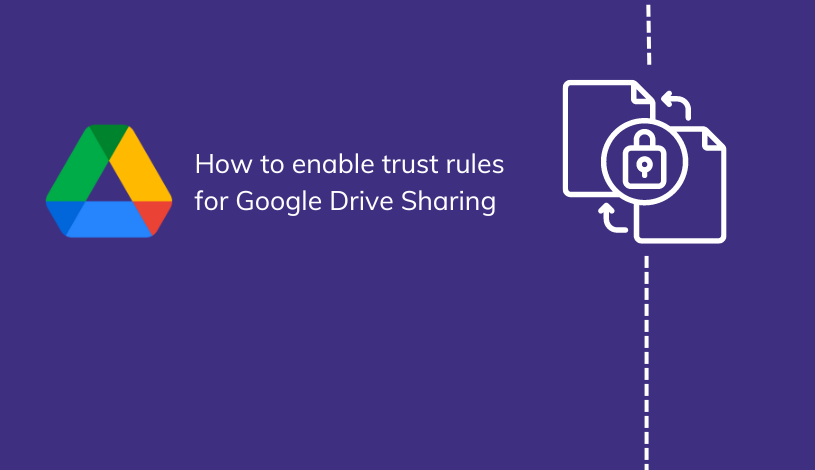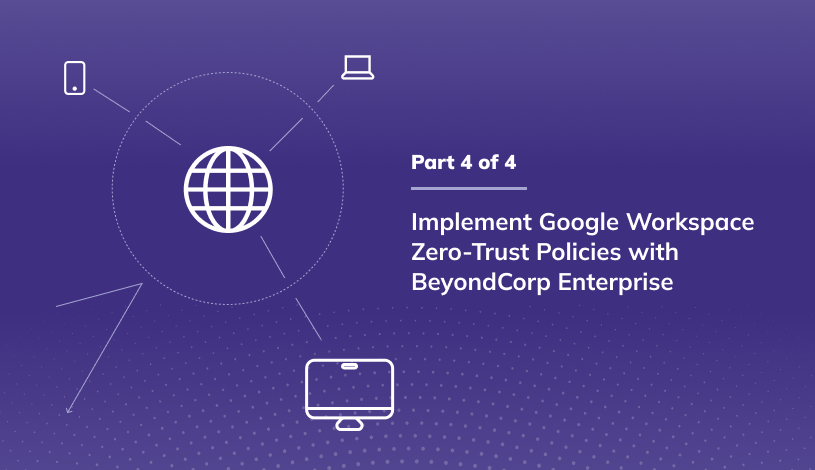Never Trust, Always Verify: How Context-Aware Access Powers Zero Trust
Beyond the Gates – Why Traditional Security Isn't Enough
The modern digital landscape is a dynamic storm of hybrid work, multi-cloud environments, and countless interconnected devices. In this reality, traditional, static access control is like a castle wall in an age of air travel—it's no longer enough. Legacy methods, rooted in fixed roles and network perimeters, operate on an "all-or-nothing" principle. Once a user is inside, they often have broad access, creating significant security gaps and a wide-open attack surface.
This reality demands a fundamental shift in cybersecurity philosophy. The old model of implicit trust is giving way to an identity-centric approach that demands verification at every step.
Enter Context-Aware Access (CAA), a sophisticated and adaptive security strategy built for this new frontier for Google Workspacee customers. CAA moves beyond simple identity checks, dynamically adjusting access permissions in real-time based on a multitude of contextual factors. This isn't just a technological upgrade; it's a strategic imperative for any modern enterprise seeking resilient security.
At its core, CAA is a cornerstone of the Zero Trust security model. The Zero Trust framework operates on the principle of "never trust, always verify," meaning no user or device is inherently trusted. Every access request is continuously scrutinized, and CAA provides the granular control and continuous assessment needed to make Zero Trust a practical reality.
In This Article:
-
What CAA Is: Moving from static, "all-or-nothing" rules to dynamic, risk-based decisions.
-
The Pillars of Context: The key factors—like device health, location, and user behavior—that drive smart access decisions.
-
The Core Benefits: How CAA enhances security, improves user productivity, and streamlines compliance.
-
Implementation Guide: Best practices for a successful rollout and common challenges to avoid.
How It Works: The Pillars of Smart Access Decisions
Context-Aware Access (CAA) in Goolge Workspace adjusts access permissions by evaluating real-time factors like user location, device status, and even behavioral patterns. It relies on continuous risk assessments to make more precise, intelligent security decisions.
The key distinctions from traditional methods are profound:
-
Granular vs. All-or-Nothing: Instead of a simple "yes/no," CAA provides meticulous control, restricting access to specific applications, data sets, or even actions within an app.
-
Adaptive vs. Static Rules: Traditional security uses fixed rules. CAA dynamically adapts to changing conditions. If a user moves from a secure office network to public Wi-Fi, CAA can automatically re-evaluate and modify their access permissions in real-time.
-
Risk-Based vs. Binary Decisions: CAA intelligently determines when to increase security. Instead of requiring Multi-Factor Authentication (MFA) for every login, it can prompt for it only when a suspicious login or elevated risk is detected, enhancing both security and user experience.
The intelligence of CAA is driven by a rich array of "contextual factors." The following table summarizes the key elements that inform every access decision:
|
Factor Category |
Specific Factor |
Description |
Example Use Case |
|
User |
User Identity & Role |
Who the user is, their job function, and assigned privileges. |
A financial executive has access to sensitive dashboards, while an intern does not. |
|
Behavioral Patterns |
Typical user activity, login habits, and deviations from the norm. |
If a user logs in from an unusual location or at an odd hour, additional verification is prompted. |
|
|
Device |
Device Posture & Security Status |
The health, compliance, and security features of the device (e.g., OS version, encryption, patches). |
Access is granted only if the device is company-issued, encrypted, and has the latest OS updates. |
|
Device Type |
Classification of the device accessing the resource (e.g., desktop, laptop, mobile). |
Restrict access to certain applications only from corporate laptops, not personal mobile devices. |
|
|
Environment |
Geographic Location |
The physical location from which the access request originates. |
Deny access to sensitive data if the user is outside the corporate network or a pre-approved country. |
|
Network Environment |
The type of network connection used (e.g., secure corporate VPN, public Wi-Fi). |
Allow full access from a trusted corporate network, but require MFA from public Wi-Fi. |
|
|
Time |
Time of Access |
The specific time and day of the access attempt. |
Block access to critical systems during non-business hours unless explicitly authorized. |
|
Resource |
Resource Sensitivity |
The classification or sensitivity level of the data or application being accessed. |
Grant read-only access to public documents, but require higher authentication for confidential reports. |
|
Relationship |
Relationship Context |
Connections between users and resources, or social/organizational relationships. |
A team lead has elevated access to project files of their direct reports. |
The Unmistakable Benefits: Why Your Organization Needs CAA
Adopting Context-Aware Access offers transformative advantages for security, productivity, and compliance.
-
Benefit 1: Drastically Enhance Security & Reduce the Attack Surface
CAA proactively adapts to threats in real-time, preventing unauthorized access without constant manual intervention. By enforcing granular policies, it effectively shrinks the attack surface, ensuring users can only access the necessary resources under the right conditions. This provides a robust defense against evolving, identity-based attacks that traditional methods often miss. -
Benefit 2: Improve User Experience & Boost Productivity
One of CAA's most powerful features is its ability to reduce security friction. It provides a smoother experience for legitimate users by applying stricter measures only when risk is detected. This means fewer unnecessary MFA prompts, which reduces "MFA fatigue" and allows employees to work more efficiently without compromising security. This resolves the age-old conflict between strong security and user productivity. -
Benefit 3: Streamline Compliance & Auditing
CAA is essential for regulatory adherence. By enforcing least-privilege principles in real-time, it simplifies the complex landscape of compliance. The system generates a comprehensive, audit-ready trail of every access decision, significantly easing the process for standards like GDPR, HIPAA, and PCI DSS. -
Benefit 4: Prevent Advanced Fraud in Real-Time
CAA offers a dynamic defense against sophisticated attacks like credential stuffing and MFA prompt bombing. By continuously scanning for anomalies—such as logins from unusual locations or suspicious VPNs—it can automatically trigger additional verification or deny transactions, preventing fraud before it happens.
Real-World Applications: CAA in Action
Context-Aware Access is already delivering value across major industries:
-
Enterprise Security: Enforcing device compliance (e.g., requiring encrypted, company-issued devices), restricting access from untrusted networks, and protecting cloud resources like VMs and storage buckets without exposing them to the public internet.
-
Financial Services: Thwarting fraud by detecting high-risk signals like unusual login locations, enabling personalized and secure authentication journeys across all digital channels, and sharing risk data to close security gaps.
-
Healthcare: Ensuring secure patient data access by controlling who can view medical records based on their role, location within a hospital, and shift time. This is critical for meeting HIPAA compliance while enabling modern practices like telehealth.
-
API Security: Securing the backbone of modern applications by analyzing each API request in full context, detecting anomalies in traffic, and verifying the integrity of devices making API calls.

Implementation Guide: A Strategic Rollout of Context-Aware Access in Google Workspace
A successful Context-Aware Access (CAA) rollout is a strategic project, not just a technical switch. It requires a thoughtful approach that balances robust security with user productivity. Follow these best practices to ensure a smooth and effective deployment.
Best Practices for a Successful Rollout
Step 1: Define Your "Why" and Identify Key Risks (The Scoping Phase)
Before you write a single rule, you must define what you are trying to achieve.
-
What it is: This is the foundational strategy session. Instead of asking "What can we block?" ask "What are we protecting, and from what?"
-
How to do it in Google Workspace:
-
Identify Sensitive Data: Pinpoint where your most critical data resides. Is it in specific Shared Drives containing financial records? Is it intellectual property in a particular Organizational Unit's (OU) Drive?
-
Define Threat Scenarios: What are your primary concerns?
-
Unmanaged Devices: Employees accessing sensitive files from personal, potentially insecure laptops.
-
Untrusted Networks: Access to core apps from public Wi-Fi without a VPN.
-
Geographic Risk: Access attempts from countries where you have no business operations.
-
- Set Clear Goals: Your goal isn't to block users; it's to "ensure all access to the 'Finance Shared Drive' comes from a company-managed and encrypted device."
-
Step 2: Plan Your Policies and Communicate Proactively
With clear goals, you can now plan the implementation and, crucially, inform your users.
-
What it is: Structuring your user base for a phased rollout and creating a communication plan to prevent surprises and reduce help desk tickets.
-
How to do it in Google Workspace:
-
Structure with OUs and Groups: Organize users into logical Organizational Units (e.g., Finance, Engineering) and Access Groups (e.g., caa-pilot-group, executives). This is essential for applying policies with precision.
-
Draft a Communication Plan: Inform users before you make changes. Explain the "why" (to better protect company data), the timeline, and what they might experience (e.g., a message asking them to use their corporate device). Provide a clear channel for questions.
-
Step 3: Start Simple and Layer Complexity
Don't try to build the perfect, all-encompassing policy on day one.
-
What it is: Begin with broad, simple rules and add more granular conditions over time. This makes troubleshooting infinitely easier.
-
How to do it in Google Workspace:
-
Initial Rule: Start with a single condition. A great first policy is an IP-based rule: "Block access to all apps if the user is not on our corporate IP range."
-
Layered Rule: Once that is working well, you can add complexity: "Block access if the user is not on our corporate IP range AND their device is not company-owned and compliant."
-
Step 4: Test Rigorously in "Monitor Mode"
This is the most critical step for preventing business disruption.
-
What it is: A Google Workspace feature that lets you apply a CAA policy without actually blocking anyone. It logs every instance where a user would have been blocked, giving you invaluable data.
-
How to do it in Google Workspace:
-
Create Your Access Level: In the Admin Console, create your desired access level (e.g., "Corporate Devices Only").
-
Assign it in Monitor Mode: When applying this access level to an app (like Gmail or Drive), choose the "Monitor" option instead of "Enforce."
-
Analyze the Logs: Let it run for at least one to two weeks. Go to Reporting > Audit and investigation > Context-Aware Access logs. Look for legitimate business activities that were flagged. You might discover an executive who only works from their home IP address, which you forgot to add to your trusted list. Refine your rules based on this data.
-
Step 5: Deploy in Phases with a Pilot Group
Never roll out a new policy to the entire organization at once.
-
What it is: A controlled, phased deployment starting with a small, tech-savvy group before expanding.
-
How to do it in Google Workspace:
-
Select Your Pilot Group: Create a Google Group (caa-pilot-group) with IT staff and a few trusted users from different departments.
-
Enforce for the Pilot: Switch the policy from "Monitor" to "Enforce" for this pilot group only.
-
Gather Feedback: Actively solicit feedback. Did they get blocked when they shouldn't have? Was the experience smooth?
-
Gradual Expansion: Once the pilot is successful, expand the policy to a broader OU, then another, until the entire organization is covered.
-
Step 6: Empower Support and Monitor Actively
Once enforced, your help desk is the front line.
-
What it is: Preparing your support team to handle inquiries and actively monitoring the health of your CAA policies.
-
How to do it in Google Workspace:
-
Train the Help Desk: Provide them with a simple FAQ. Explain what CAA is, what the common block messages mean, and the process for granting temporary access or investigating a block.
-
Monitor the Audit Logs: Keep a close eye on the Context-Aware Access logs after rollout. A sudden spike in "Access Denied" events could indicate a misconfiguration or a widespread issue.
-
Common Challenges to Avoid
-
Forgetting the User Experience: Don't create policies so restrictive that they hinder productivity. If a salesperson can't access their presentation from a client's office, the policy has failed. Always balance security with business needs.
-
The "Set It and Forget It" Mentality: Your business is not static, and neither are security threats. Review your CAA policies quarterly to ensure they are still relevant and effective.
-
Poor Communication: The fastest way to create frustration is to surprise users with new security restrictions. Over-communicating is always better than under-communicating.
-
Not Planning for Exceptions: There will always be valid exceptions. Have a clear, documented process for granting temporary access or permanently adjusting a policy for a specific use case.
Securing Tomorrow's Digital Landscape Today
Context-Aware Access is an indispensable leap forward in cybersecurity. It offers a dynamic, intelligent, and resilient approach to access management that is perfectly aligned with the Zero Trust philosophy.
By embracing the complexity of modern digital environments, CAA provides a security framework that is both robust and adaptive. It dramatically enhances security, improves the user experience, and streamlines compliance.
For any organization navigating the challenges of a hybrid workforce, multi-cloud infrastructure, and a relentless threat landscape, adopting Context-Aware Access is no longer an option—it is a strategic imperative. It is the foundation for building a future-ready security posture that can respond to risk the moment it appears.

.jpg)
.png?width=150&height=150&name=Blog%20Slide%20(1).png)


